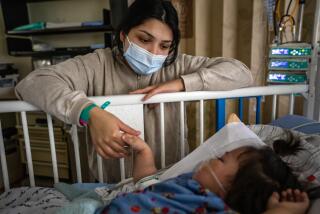Children across U.S. are becoming inexplicably paralyzed. Some parents and experts say federal officials aren’t doing enough

LaMay Axton watched in horror as her granddaughter Cambria stumbled and toppled over as she ran into the kitchen of their house. The 2-year-old tried to stand back up, but couldn’t.
“Her little legs just fell from under her, like a marionette doll,” said Axton, who lives in Menifee in Riverside County.
Within hours, Cambria was unable to move her arms or her legs. Her diaphragm stopped working, so she needed machines to breathe. In September 2016, doctors determined that she had an unexplained condition called acute flaccid myelitis.
In 2014, more than 100 children in the U.S. suddenly became paralyzed and were diagnosed with the condition, which closely resembles polio. In 2016, another outbreak paralyzed even more children. Two years later, the devastating illness is back.
Federal health officials said this week that 62 cases of acute flaccid myelitis, or AFM, have been confirmed in 2018, and 65 more possible cases are being investigated. Experts at the U.S. Centers for Disease Control and Prevention say they still don’t know what causes the syndrome.
But some parents and doctors say the CDC is not doing enough to address the malady. Many doctors believe the paralysis is caused by a summer virus and that the CDC’s decision to continue to call AFM a “mystery” illness is wrongly stoking fears among parents, and also stalling efforts to develop prevention strategies and treatments.
“It’s really hard to see these kids and know that we saw them four years ago the same way,” said Priya Duggal, an epidemiologist at Johns Hopkins Bloomberg School of Public Health who studies AFM. “And it’s scary to think that it might be the same in 2020, unless we make some changes now.”
In 2014, children started showing up in emergency rooms across the country unable to move an arm or a leg. Standard treatments didn’t seem to work, leaving doctors puzzled.
“We weren’t really sure what we were looking at at first,” said Dr. Emmanuelle Tiongson, a pediatric neurologist at Children’s Hospital Los Angeles who treated six AFM patients in 2014. “It’s not something we had seen since everyone was vaccinated against polio.”
Doctors coined a name for the condition — “acute flaccid” for the sudden and total paralysis and “myelitis” for the part of the spinal cord involved in muscle movement.
It wasn’t poliovirus, tests showed. But many patients’ lab tests did come back positive for enterovirus D-68, a cousin of poliovirus that was known to cause only a cold — though experts suspected it could have more severe consequences.
Studies confirmed that an enterovirus D-68 outbreak in 2014 lined up with the surge in paralysis cases. One study found that injecting mice with the virus caused the type of paralysis seen in children.
“I think people like me continue to believe that the majority … of these cases are linked to enterovirus D-68 infection,” said Dr. Kenneth Tyler, a neurologist at the University of Colorado who led the mouse study. “The CDC has been, I think, exceedingly cautious.”
Federal health officials said this week that although some AFM patients had enteroviruses in their systems, many did not. CDC experts say they are considering a wide range of possible causes, including other viruses, autoimmune conditions and environmental toxins.
Her toddler suddenly paralyzed, mother tries to solve a vexing medical mystery »
“This is a mystery so far and we haven’t solved it yet, so we have to be thinking broadly,” Dr. Nancy Meissonnier, director of the CDC’s National Center for Immunization and Respiratory Diseases, told reporters this week.
She said the agency was expanding its efforts to investigate AFM, but emphasized the condition remains rare — 386 cases in the United States since 2014.
Dr. Roberta DeBiasi, chief of the division of pediatric infectious disease for Children’s National in Washington, D.C., said officials don’t yet know if AFM is due to an enterovirus infection. Scientists would need to find the virus in the spinal fluid of affected children — proof that it traveled there and caused motor damage — but they haven’t yet. Some children with AFM have even tested positive for completely different viruses.
“I don’t think it would be possible for anyone to say with certainty that it’s due to the enterovirus,” she said.
Because experts are unsure what causes the disease, the CDC recommended a broad range of safety precautions, including hand washing, staying up to date on vaccinations and using insect repellent to ward off mosquito bites.
But many caregivers feel frustrated by a lack of answers in the face of such a grave illness. There are essentially no medical treatments that work for these patients.
Two years after Cambria first got sick, one of her arms and one of her legs is still paralyzed. She is just now relearning how to walk.
“There is nothing pretty about AFM,” said Axton, her grandmother. “It is much like polio and the iron lungs and all of that, but it’s 2018 and we just deserve answers.”
Riley Bove’s son, Luca, was diagnosed with AFM in 2014 when he was 4 years old.
Four years later, Luca’s right shoulder remains paralyzed, so he has switched to writing and eating with his left hand. He wears a neck brace to protect his weakened neck from dangerously flopping backward and causing a spinal injury.
“The neck is a constant safety issue, so birthday parties — no bouncy castle, can’t play soccer with his friends unless they’re supervised, can’t do any contact sports,” said Bove, who is a neurologist at UC San Francisco. “He’s 8, but he’ll probably have to have safety car seats for a long, long time.”
The average patient age is 4, though doctors don’t know why that age group is particularly vulnerable. Experts also don’t understand why the outbreaks seem to hit every other year.
Still, Dr. Kevin Messacar, a pediatric infectious disease specialist at Children’s Hospital Colorado in Aurora, said the “label of ‘mystery illness’ is a little misleading.”
In Colorado, Messacar has seen acute flaccid myelitis patients with enterovirus D-68 and others with a related virus, enterovirus A71. He hopes the CDC will focus on an enterovirus vaccine, given the serious consequences of AFM.
“The vast majority of children who have this have, unfortunately, long-term paralysis and disability. How do we prevent this if it does come back? Or God forbid, come back in a bigger way?” he said.
Parents of children with AFM often recall that the whole family had caught a cold, but only one child went on to develop AFM. Duggal, the Johns Hopkins researcher, is investigating whether the child that experienced the most severe consequences perhaps had a genetic mutation that put it at risk.
Before it was eradicated in the U.S. in the 1970s, poliovirus also gave thousands of people mild symptoms each year, while only a small fraction developed the characteristic paralysis, suggesting a genetic factor at play.
“In some ways, it doesn’t fully matter which virus it is — something is circulating that makes people sick — but what makes people susceptible to paralysis is what’s important,” said Duggal.
Carlene Burns’ 4-year-old daughter, Maipele, was diagnosed with AFM in 2016. Last year, she underwent surgery at Children’s Hospital Los Angeles to try to improve function in her paralyzed right arm.
Maipele is one of 15 children who have been operated on by plastic surgeon Dr. Mitchel Seruya. He connects nerves from other parts of the body to the paralyzed limbs.
Now, Maipele can bend her elbow and close and open her fingers slightly, her mother says.
“It’s not going to reverse everything,” Seruya said. “But if it’s somebody with an isolated limb, like just an arm or just a leg, we can do some real good with that and bring them back to as much function as possible.”
Twitter: @skarlamangla
More to Read
Sign up for Essential California
The most important California stories and recommendations in your inbox every morning.
You may occasionally receive promotional content from the Los Angeles Times.











